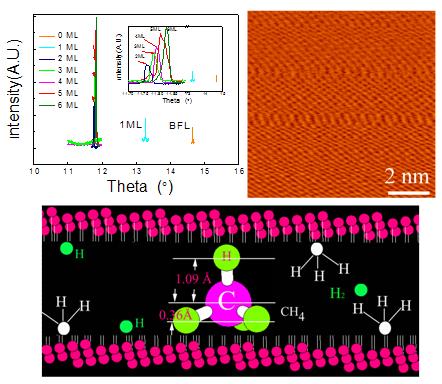| Preparation of Quasi-Free Standing Graphene with a Super Large Interlayer Distance by Methane Intercalation |
| From: PublishDate:2012-06-25 Hits: |
Graphene is regarded as a new fantastic material because of its single atomic thickness, high symmetry and relativistic charge carrier behaving like massless Dirac Fermions. Since its discovery, preparation of high quality graphene as host materials for devices has become a key factor for its further development. However, Graphitization process of multilayer graphene is inevitable, if the number of graphene layers (NGL) increases without any further proper measures.Preparation of graphene in multi-layer behaving like a quasi-free standing monolayer remains elusive. Qingsong Huang and coworkers present a route to graphene epitaxially grown on SiC (0001) by exposing sample to hydrogen, which is accompanied by intercalation of hydrogen and related organic molecules under high temperatures, much different from those in previous works performed under low temperatures (below 600 oC)., leading to a uniform intercalation in the cooling process after heat decomposition. When the NGL increases more than 1 ML, the penetration (intercalation) of methane atoms to interspaces of two adjacent layers happens, so that the interlayer distance between two adjacent layers (IDTL) will be enlarged by this intercalation, even more than the distance of AA stacking (3.4693 Ǻ). This abnormally large distance can decouple the two adjacent layers, and make each layer quasi-free standing. This intercalation by methane and methyl group (–CH3) species is much better than that by the high density of rotational faults in the EG on SiC (000-1), where the graphitization should be inevitable with increasing of the NGL.
By utilizing the XRD method at Beijing Synchrotron Radiation Facility (BSRF), the inter-distance of the two adjacent layers (IDTL) can be characterized accurately. Despite of the NGL changing, the XRD-peak positions are almost kept unchanged, which represents the intercalation can be performed effectively and uniformly in random layers, even the NGL of film is different. Furthermore, with the NGL increasing, the reduction of IDTL can be attributed to the graphitization process. Without intercalation, the graphitization process will proceed very quickly because of the interlayer coupling. Here, the IDTL has a minimum value, no less than the radius of intercalation species, so that the charge carriers of graphene can be kept like massless Dirac Fermions because of the abnormally large IDTL by the intercalation of methane, regardless of the number of graphene layers. Thus, the preparation of graphene will become simple, effective and promise in application. It can also be expected that, graphene can be observed with naked eyes, just like a sheet of paper as host materials. For more detail please refer to the article published in J. Phys. Chem. C. The research results provide an effective route to the graphene in high quality, which makes the graphene to be decoupled from its adjacent layers and to be used widely and prepared easily in large scale. Synchrotron radiation sources have helped us to unveil the inter-distance between two adjacent layers accurately, by which the abnormally large IDTL has been disclosed and makes the coupling between the adjacent layers very weak. The synchrotron radiation techiques can reveal not only the relationship between the inter-distance of the IDTL and the number of layers, but also the misorientation between the adjacent layers. The synchrotron has played an important role in structurally characterizing graphene. Article: Qingsong Huang,Xiaolong Chen,*Jingjing Lin,Kang Li,Yuping Jia,Jun Liu, Liwei Guo,Wenjun Wang,and Gang Wang, Preparation of Quasi-Free-Standing Graphene with a Super Large Interlayer Distance by Methane Intercalation, J. Phys. Chem. C, 2011, 115, 20538–20545. |
|
|
| Chinese
Science Highlights
Home /
Copyright © 2011 - 2012 Beijing Synchrotron Radiation Facility


